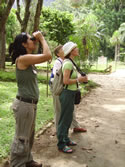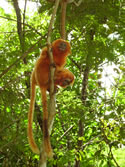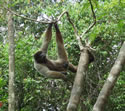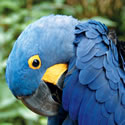

Golden Tamerins,
Jaguars,
Piranhas, and More
Wild About Brazil
Text By Sandra Scott
 “Look!
A brown capuchin monkey!” Regina, the tour guide, pointed up in
the tree. Sure enough there was the monkey pulling the flower off a
bromeliad and eating the tender stems. Ripe nuts from the rubber trees
were popping open and dropping to the ground providing a buffet for
the birds. “Amazing!” I exclaimed, “Here we are in
the middle of Rio de Janeiro with monkeys and birds everywhere!”
“Look!
A brown capuchin monkey!” Regina, the tour guide, pointed up in
the tree. Sure enough there was the monkey pulling the flower off a
bromeliad and eating the tender stems. Ripe nuts from the rubber trees
were popping open and dropping to the ground providing a buffet for
the birds. “Amazing!” I exclaimed, “Here we are in
the middle of Rio de Janeiro with monkeys and birds everywhere!”
 An
afternoon shower moved in and people took shelter in the Botanical Gardens’
orchid house. I passed the time chatting with a lady who had just returned
from the Pantanal with International Expedition. After expressing my
amazement at the wildlife in Rio, Sarah, from Maryland, countered with,
“You ought to go to the Pantanal. When we arrived at Refugio Ecological
Caiman a giant anteater came moseying around the building. They are
not easy to find and it found us! And, the first time I saw a Hyacinth
Macaw I was astounded by the iridescence color. I saw so many that it
is hard to believe they are endangered.”
An
afternoon shower moved in and people took shelter in the Botanical Gardens’
orchid house. I passed the time chatting with a lady who had just returned
from the Pantanal with International Expedition. After expressing my
amazement at the wildlife in Rio, Sarah, from Maryland, countered with,
“You ought to go to the Pantanal. When we arrived at Refugio Ecological
Caiman a giant anteater came moseying around the building. They are
not easy to find and it found us! And, the first time I saw a Hyacinth
Macaw I was astounded by the iridescence color. I saw so many that it
is hard to believe they are endangered.”
No doubt about it! Brazil is wild! The Amazon was my “wild” destination; but, catching the enthusiasm of the small International Expedition group, and to experience more of Brazil’s wildness, I joined their three-day add-on trip in search of the golden lion tamarin, one of the world's most endangered species.
 Spectacular
two-hour drive took us to Poco das Antas Biological Reserve, one of
the few places to see tamarins in the wild. Our guide led us on a short
walk to a line of trees where we stood quietly listening for the telltale
rustling in the trees, then a someone whispered, “There they are!”
Sure enough the tamarins had arrived, their long glowing golden fur
glistening with droplets of rain. For over an hour I watched them eat,
groom each other, and leap from tree to tree. National Zoo Scientists
and collaborators in Brazil introduced zoo-born golden lion tamarins
into the forests, primarily onto private lands where the owners have
kept the forest intact providing the necessary habitat for sustainability.
During the 35-year project, the tamarin population in Brazil’s
Atlantic Coastal Forest rose from 200 to 1,500. The program has been
“wildly” successful.
Spectacular
two-hour drive took us to Poco das Antas Biological Reserve, one of
the few places to see tamarins in the wild. Our guide led us on a short
walk to a line of trees where we stood quietly listening for the telltale
rustling in the trees, then a someone whispered, “There they are!”
Sure enough the tamarins had arrived, their long glowing golden fur
glistening with droplets of rain. For over an hour I watched them eat,
groom each other, and leap from tree to tree. National Zoo Scientists
and collaborators in Brazil introduced zoo-born golden lion tamarins
into the forests, primarily onto private lands where the owners have
kept the forest intact providing the necessary habitat for sustainability.
During the 35-year project, the tamarin population in Brazil’s
Atlantic Coastal Forest rose from 200 to 1,500. The program has been
“wildly” successful.
Before returning to Rio, we went on a bird-watching hike in Serra dos Orgaos Park and got lucky. We spotted a Black and Gold Cotinga, a rare bird endemic to the Atlantic rainforest park. Another wild experience!
 From
Rio I caught my pre-scheduled flight to Manaus, a city of two million
people in the middle of the Amazon. Shortly after I arrived at the Tropical
Hotel on the edge of the city, Gustave J., the manager said, “Today
is a big day for us. Any minute now a rescued jaguar will arrive to
join our hotel’s zoo. Want to watch?” Of course!
From
Rio I caught my pre-scheduled flight to Manaus, a city of two million
people in the middle of the Amazon. Shortly after I arrived at the Tropical
Hotel on the edge of the city, Gustave J., the manager said, “Today
is a big day for us. Any minute now a rescued jaguar will arrive to
join our hotel’s zoo. Want to watch?” Of course!
The Tropical Hotel is approved by the Brazilian environmental agency, IBAMA, to accept rescued animals. I arrived at the zoo nestled under the trees behind the hotel just as the truck bearing the jaguar arrived. The crate was propped up at the opening of the newly built jaguar home. With the hotel veterinarian in charge, we waited in heightened anticipation for the jaguar to awaken from his induced sleep. Finally a spotted head appeared. What a magnificent creature! Slowly and groggily the jaguar crawled out of the crate into his new home, staggered over to a corner, and went back to sleep. When I checked an hour later he was on the prowl inspecting his new home.
 From
Manaus a thirty-minute boat ride took me to Eco Park Lodge, my jungle
home for a couple of days. Located on a tributary of the Rio Negro,
Eco Park is just one of many jungle lodges in the Brazilian Amazon.
After a lunch that was eyed covetously by a scarlet macaw, I met Iury,
my guide, and set out on a nature hike. The trained eye of Iury spotted
signs of nature that I would have missed. Each critter and every plant
had special significance to Iury. He knew the tree that was the “telephone”
of the jungle. By banging on it with his “best friend,”
his machete, the sound reverberated through the jungle signaling the
need for assistance. If he needed water he knew what vine to cut to
find plenty of fresh water. Iury pointed out tree frogs, lizards, birds
and other wildlife my untrained eyes missed. Amazed at his vast knowledge,
I asked, “Where did you learn all this?”
From
Manaus a thirty-minute boat ride took me to Eco Park Lodge, my jungle
home for a couple of days. Located on a tributary of the Rio Negro,
Eco Park is just one of many jungle lodges in the Brazilian Amazon.
After a lunch that was eyed covetously by a scarlet macaw, I met Iury,
my guide, and set out on a nature hike. The trained eye of Iury spotted
signs of nature that I would have missed. Each critter and every plant
had special significance to Iury. He knew the tree that was the “telephone”
of the jungle. By banging on it with his “best friend,”
his machete, the sound reverberated through the jungle signaling the
need for assistance. If he needed water he knew what vine to cut to
find plenty of fresh water. Iury pointed out tree frogs, lizards, birds
and other wildlife my untrained eyes missed. Amazed at his vast knowledge,
I asked, “Where did you learn all this?”
 “From
my father, who learned from his father, and now I am teaching my son,”
he explained.
“From
my father, who learned from his father, and now I am teaching my son,”
he explained.
That evening Iury took me on a caiman-spotting adventure. In a small
wooden boat we poled through the mangrove and saw only a few caiman.
Gliding under the trees, with the moonlight dappling the black water,
the constant cric-cric of the frogs, and an occasional buzz of an insect
was a surreal experience.
“Where are all the mosquitoes?”
“This is the Rio Negro, the Black River, and there are very few
mosquitoes here. The leaching of tannin from the decaying leaves causes
the black color and makes it acidic. Black water is some of the cleanest
water in the world. The mosquitoes don’t like it!”
 Each
day was an adventure in the wilds of the Amazon. Leaving my air-conditioned
cabin in the morning I paused to watch the monkeys capering in the trees,
slowed down to let a lizard cross my path, watched flittering butterflies,
and listened to chirping birds. One morning I tried my luck piranha
fishing, even though I only caught one, I did see a rare passion flower
in bloom, and more birds and butterflies than I could count. On the
way back to the Lodge, I visited the Primate Rehabilitation Center,
an IBAMA approved center for primates confiscated from illegal sales
and reintroduced to the rain forest. It was a thrill to see a red-faced
uakari with its human-like face and observe the wooly monkeys swinging
from tree to tree.
Each
day was an adventure in the wilds of the Amazon. Leaving my air-conditioned
cabin in the morning I paused to watch the monkeys capering in the trees,
slowed down to let a lizard cross my path, watched flittering butterflies,
and listened to chirping birds. One morning I tried my luck piranha
fishing, even though I only caught one, I did see a rare passion flower
in bloom, and more birds and butterflies than I could count. On the
way back to the Lodge, I visited the Primate Rehabilitation Center,
an IBAMA approved center for primates confiscated from illegal sales
and reintroduced to the rain forest. It was a thrill to see a red-faced
uakari with its human-like face and observe the wooly monkeys swinging
from tree to tree.
 From
Manaus I flew to Salvador Bahia on the Atlantic Coast where I learned
about a “wild” volunteer project. Tania G., the manager
at the Holiday Inn, told us, “I lived in Praia do Forte where
the TAMAR Project conducts research and protects the endangered sea
turtles. It is just a few miles from Salvador. In fact I adopted a baby
turtle and released it into the ocean.” The release project came
about because the turtle population was rapidly declining due to the
selective killing of the females as they came ashore to lay their eggs.
The project has successfully increased the turtle population. I was
sorry I missed the prime release time, which is January and February.
It will give me another excuse to visit wild Brazil.
From
Manaus I flew to Salvador Bahia on the Atlantic Coast where I learned
about a “wild” volunteer project. Tania G., the manager
at the Holiday Inn, told us, “I lived in Praia do Forte where
the TAMAR Project conducts research and protects the endangered sea
turtles. It is just a few miles from Salvador. In fact I adopted a baby
turtle and released it into the ocean.” The release project came
about because the turtle population was rapidly declining due to the
selective killing of the females as they came ashore to lay their eggs.
The project has successfully increased the turtle population. I was
sorry I missed the prime release time, which is January and February.
It will give me another excuse to visit wild Brazil.
 It
is easy to be wild about Brazil. The wildlife can be found everywhere
– on the savanna, along the coast, in the rainforest, and even
in the cities. To be able to see so many animals and birds in one country,
especially those on the endangered list, is an amazing and “wild”
experience.
It
is easy to be wild about Brazil. The wildlife can be found everywhere
– on the savanna, along the coast, in the rainforest, and even
in the cities. To be able to see so many animals and birds in one country,
especially those on the endangered list, is an amazing and “wild”
experience.
If you go:
Brazil Tourist Office: www.braziltour.com,
(800) 7-BRAZIL
International Expedition: www.ietravel.com,
(800) 633-4734
EcoAdventures: www.EcoAdventures.com,
(800) 326-5025
TAMAR Turtle Project: www.projetotamar.org.br
Brazil EcoTravel: www.brazil-ecotravel.com
Hyacinth Macaw image courtesy of International Expedition
Turtle image courtesy of TAMAR Turtle Project
Search the Web for related information on Brazil
Home | North
America | South & Central America | Europe
Asia & Middle East | Africa
| Oceania | Favorite
Accommodations
Travel Images Blog
| Preferred
Accommodations Blog
Travel Blog | Columns
| About Sandra | Contact
Sandra | Site Map
Copyright
© 2002-2007 Sandra Scott. ALL RIGHTS RESERVED
Site
designed and created by C.F. Howley